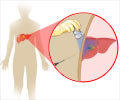Radiofrequency ablation is an effective treatment for dysplasia in people with Barrett's esophagus, a condition that can lead to deadly gastrointestinal cancer
Radiofrequency ablation is an effective treatment for dysplasia in people with Barrett's esophagus, a condition that can lead to deadly gastrointestinal cancer, according to a landmark clinical trial led by a University of North Carolina at Chapel Hill researcher.
"These results show there is a substantial difference between treatment with radiofrequency ablation and a placebo or 'sham' treatment," said Nicholas Shaheen, M.D., principal investigator of the study, associate professor in the UNC Schools of Medicine and the UNC Gillings School of Public Health and director of UNC's Center for Esophageal Diseases and Swallowing. "It's a strongly positive finding."The study is published in the May 28, 2009 issue of the New England Journal of Medicine.
Barrett's esophagus is a condition in which repeated acid reflux causes the cells that normally line the esophagus to be replaced by a different type of cell, similar to those normally found in the intestines. This process is called intestinal metaplasia. By itself Barrett's is not a life-threatening problem, but a small percentage of people with Barrett's will develop esophageal adenocarcinoma, an especially deadly form of cancer.
Radiofrequency ablation (RFA), a non-invasive technique that uses thermal energy, or heat, to destroy cells, is very effective at destroying abnormal cells in the esophagus. The new UNC-led study is the first randomized trial to evaluate radiofrequency ablation for treating dysplasia, a more advanced stage of Barrett's esophagus in which the abnormal cells acquire precancerous traits.
The RFA system used in the study uses thermal energy provided by a set of electromagnetic coils on the surface of a balloon, Shaheen said. "The balloon is placed in the area of the esophagus where the offending cells are and the balloon is inflated. Energy is then passed through the electromagnetic coils and, because we know how far apart the coils are spaced and how much energy is being put through them, we get a very reliable depth of burn, such that you can kill the abnormal cells on the inner surface without damaging the whole organ."
In the study, 127 people were randomized to receive either radiofrequency ablation or a simulated, "sham" version of the procedure at one of 19 participating medical centers. Among those with low grade dysplasia who received radiofrequency ablation, 90.5 percent were free of dysplasia 12 months after treatment, compared to 22.7 percent in those who received the sham procedure. Among those with high grade dysplasia, 81 percent who received radiofrequency ablation had complete eradication of intestinal metaplasia, compared to 19 percent in the sham group.
Advertisement
The study concluded that RFA demonstrated a high rate of eradication of dysplasia and intestinal metaplasia and that these changes reduced the risk of progression towards dysplasia and the risk of developing cancer.
Advertisement
Source-Eurekalert
RAS










